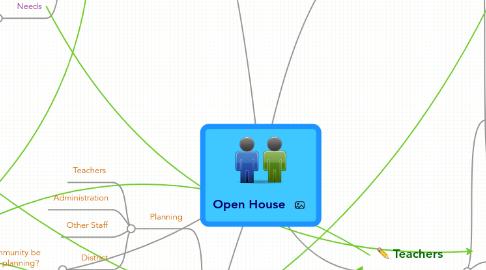
1. Students
1.1. Behavior
1.1.1. Interaction with family
1.1.1.1. Listening to others?
1.1.1.2. School environment
1.1.2. Interaction with students
1.1.2.1. Interested?
1.1.2.2. Communication?
1.1.3. Interaction with teacher
1.1.3.1. Language
1.1.3.2. Interests
1.1.3.3. Curriculum
1.1.3.4. Classroom
1.2. Involvement
1.2.1. Questions
1.2.1.1. Teachers actively listen
1.2.1.2. Teachers encourage questioning
1.2.2. Concerns
1.2.2.1. How do students and teachers communicate these?
1.2.3. Interests
1.2.3.1. Teachers incorporate student interests
1.2.4. Ability
1.2.4.1. Special needs?
1.3. Needs
1.3.1. Social
1.3.2. Emotional
1.3.3. Academic
1.3.3.1. How are these communicated?
1.3.3.2. Special needs?
1.3.4. Behavior
1.3.4.1. Special needs?
1.3.4.2. Issues/concerns
1.3.5. Language
1.3.5.1. Home language?
1.3.6. Cultural
1.3.6.1. Address assumptions
1.3.6.2. Mental models?
2. Community
2.1. Shared Vision
2.1.1. How does the community get involved?
2.1.2. How do families view open house?
2.1.3. How do schools get support from community members?
2.2. Team Building
2.2.1. How can schools get input from the community?
2.2.2. How can open house be improved?
2.2.3. What are teacher roles?
2.2.4. What are family roles?
2.3. Mental Models
2.3.1. What models are formed by community members and schools?
2.3.2. How do we address these?
2.4. Parent Involvement
2.4.1. How do schools get input from parents?
2.4.2. What are student roles?
2.4.3. How can communication be improved?
3. School
3.1. Planning
3.1.1. Teachers
3.1.2. Administration
3.1.3. Other Staff
3.1.4. District
3.1.4.1. How can the community be more involved in planning?
3.1.4.1.1. Shared vision?
3.2. Implementing
3.2.1. How could open house be improved?
3.2.2. Teacher input
3.2.3. Staff input
3.2.4. Parent input
3.2.5. Administration input
3.3. Feedback
3.3.1. From families
3.3.2. From teachers
3.3.3. Changes?
3.3.4. Positives?
4. Parents
4.1. Communication
4.1.1. Parents receive information
4.1.1.1. From school
4.1.1.2. From teacher(s)
4.1.2. Parents ask questions
4.1.2.1. Curriculum
4.1.2.2. Roles
4.1.2.3. Expectations
4.1.2.4. Issues
4.1.2.5. Student needs
4.1.3. Parents present important information
4.2. Involvement
4.2.1. Volunteer opportunities
4.2.1.1. How can parents be involved?
4.2.1.2. What information is needed?
4.2.1.3. What are parents' talents, skills?
4.2.2. Homework
4.2.2.1. What is the parents' view?
4.2.2.2. What is the teacher's view?
4.2.2.3. Expectations
4.2.3. School committees
4.2.3.1. How can schools connect with families?
4.2.3.2. How would parents like to be involved?
4.2.4. Community
4.2.4.1. How can schools connect with the community?
4.2.4.2. What does the community need?
4.3. Concerns
4.3.1. Behavior
4.3.2. Academic
4.3.3. Social
4.3.4. Language
5. Teachers
5.1. Communication
5.1.1. Language barriers?
5.1.2. Cultural issues?
5.1.3. Teachers listen to families
5.1.3.1. Address assumptions?
5.1.4. Teachers answer questions
5.1.5. Verbal/oral and written forms?
5.1.6. Other school staff involved?
5.1.6.1. Team building?
5.2. Interaction
5.2.1. How do parents interact?
5.2.2. How do students interact?
5.2.3. Teachers interact with families
5.2.3.1. Mental models?
5.2.4. Teachers seek community involvement
5.3. Information
5.3.1. Present curriculum
5.3.2. Get contact/student information
5.3.3. Explain procedures
5.3.4. What feedback do families have?
5.3.5. How do teachers get families involved?
5.3.5.1. Shared vision?
5.3.6. Teachers get feedback from families
